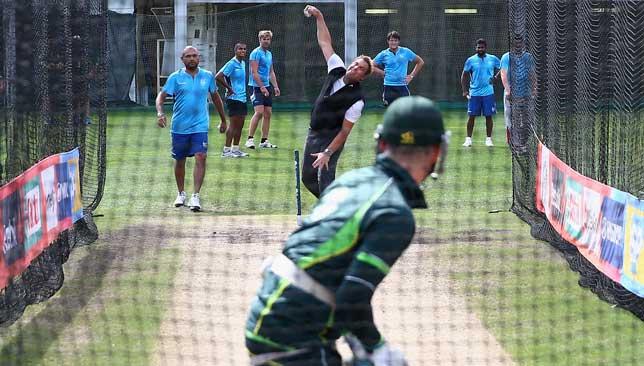
During Australia’s nets session, came the most telling sign that they are feeling a bit apprehensive about Indian spinners – as they enlisted the help of legendary leg-spinner Shane Warne to bowl at their batsmen.
– #CWC15: Brett Lee hails Australia balance ahead of India semi-final
– #CWC15 Diary: Bonanza for Indian supporters after Hindi commentary
– #CWC15: Australia batsman Finch not losing sleep over dip in form
Warne spent a considerable amount of time preparing the Australian batsmen, and it was clear that he had not lost any of his old guile as he not only clean-bowled James Faulkner, he also beat Aaron Finch several times with his flight and spin. So much so, a group of fans watching the proceedings got all excited and started chanting ‘Come back Warnie’.
An unusual amount of excitement can be sensed among the Indian fans here, as well as on social media, that their team will have an upper hand today, especially as the match is being played in Sydney Cricket Ground.
There is a belief, fuelled by several experts voicing their opinions on similar lines, that the pitch for the World Cup semi-final will assist the spinners, and because India have a decidedly better set of tweakers, they will have the edge.
“@CricketAus: The King in action at the @scg today… #cwc15 #AUSvIND pic.twitter.com/CSRJPKx9FA”#god @ShaneWarne
— Cameron (@cameron_dore) March 25, 2015
Tom Parker, the curator of Sydney Cricket Ground, has been a much-wanted man by the media curious to know what kind of a surface he is preparing for the battle. He has refused to speak and is apparently under a gag order by the International Cricket Council (ICC).
Australian captain Michael Clarke said there was a tinge of green on the rectangle, but he wasn’t sure for how long it would remain that way.

Going by the previous match on Sydney Cricket Ground – and they are using the same pitch that was used during the South Africa v Sri Lanka quarter-final – one would be lulled into a false belief that it is a spinner-friendly wicket.
Obviously, Imran Tahir and JP Duminy took seven wickets between them as Sri Lanka were bowled out for a paltry 133, but the ball hardly turned that day. Tahir can obviously let it rip and uses a lot of finger during delivery, which gives him some purchase on any wicket, but Duminy was almost straight as an arrow.
It really was the intense pressure created by the South African fast bowlers, and their brilliant fielding, which let the spinners take advantage, a fact that Sri Lankan batsman Kumar Sangakkara admitted after the match.
So, how will the semi-final between India and Australia work out?
A cursory look at the stats from the first 47 matches this World Cup clearly indicates that the teams that remain in the competition have bowled brilliantly.
While the contribution of the spinners has been vital in New Zealand, India and South Africa reaching the semi-finals, they are not the ones who have made the biggest impact so far.
That honour goes to left-arm fast bowlers. The two most successful bowlers in the tournament have been Trent Boult (21 wickets, 15.76 average, 4.41 economy rate) and Mitchell Starc (18, 9.77 avg, 3.74 ER). Mohammad Shami, Jerome Taylor, Morne Morkel (all 17 wickets each) and Wahab Riaz (16) are the next four best.
@trent_boult is leading with 21 wickets in 8 matches of the @ICC World Cup 2015. pic.twitter.com/0Tzis7CeX1 @BLACKCAPS #CWC15
— Muhammad Faisal Ali (@Ali_Faisal_12) March 25, 2015
The top-six of that list does not include a single spinner, who come later with Daniel Vettori and Tahir picking up 15 wickets each. India’s Ashwin has 12 wickets with an average of 24 and an economy rate of 4.29.
The big difference between the teams that reached semi-finals is that while India, New Zealand and South Africa benefited from their spinners in the middle overs, Australia have relied mainly on their pace attack to get the job done.
However, as evident from the stats, the left-arm seamers are the ones to watch out for. The angle they manage to create has troubled most batsmen. And while Australia may not have a quality spinner in their side, they do have two of the best left-arm fast bowlers in Starc and Mitchell Johnson.
That is one variety of bowling that India do not have, but their seamers – Shami, Umesh Yadav and Mohit Sharma – have done a fantastic job so far, and they are the only team that have taken all 70 opposition wickets in seven matches so far.
Unlike India, for whom all four main bowlers have taken in excess of 12 wickets each, Australia have Starc at 18, followed by Johnson at 10 and the next best is Josh Hazlewood (6 wickets).
Doherty, Maxwell, Watson haven’t taken too many wickets with starc doing the bulk of the damage in almost every match.#CWC15
— Aneesh Vamsi (@Aneeshvamsi30) March 25, 2015
India haven’t allowed a single team to reach a score of 300-plus, and that would be the key against Australia today. And when they bat, they need to play out Starc’s overs with care. If they can do that, there is no reason why they should not be travelling to Melbourne for the March 29 final.